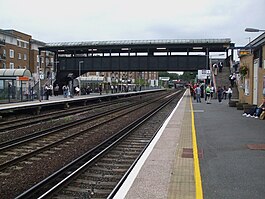
Back كينسينغتون (أولمبيا) (محطة مترو أنفاق لندن) Arabic Gorsaf reilffordd Kensington (Olympia) Welsh Bahnhof Kensington (Olympia) German ایستگاه کنزینگتون (المپیا) Persian Gare de Kensington Olympia French 肯成段俄林劈站 GAN Kensington (Olympia) állomás Hungarian Stazione di Kensington (Olympia) Italian ケンジントン・オリンピア駅 Japanese Stazion de Kensington (Olympia) LMO
| Kensington (Olympia) | |
|---|---|
 Southbound view from Platform 2 as seen in August 2008 | |
| Location | Olympia |
| Local authority | Royal Borough of Kensington and Chelsea |
| Managed by | London Overground |
| Station code(s) | KPA |
| DfT category | C2 |
| Number of platforms | 3 (2 NR/LO, 1 LU) (facing 4 tracks) |
| Accessible | Yes[1] |
| Fare zone | 2 |
| London Underground annual entry and exit | |
| 2019 | |
| 2020 | |
| 2021 | |
| 2022 | |
| 2023 | |
| National Rail annual entry and exit | |
| 2019–20 | |
| – interchange | |
| 2020–21 | |
| – interchange | |
| 2021–22 | |
| – interchange | |
| 2022–23 | |
| – interchange | |
| 2023–24 | |
| – interchange | |
| Railway companies | |
| Original company | West London Railway |
| Pre-grouping | West London Railway |
| Post-grouping | West London Railway |
| Key dates | |
| 27 May 1844 | first station opened |
| 1 Dec.1844 | first station closed |
| 2 June 1862 | second (present) station opened |
| 1940 | station closed |
| 1946 | station reopened |
| Other information | |
| External links |
|
| Coordinates | 51°29′55″N 0°12′39″W / 51.4986°N 0.2108°W |
Kensington (Olympia) is an interchange station between the Mildmay line of the London Overground and National Rail services operated by Southern, located in Kensington, West London. Limited services on the District line of the London Underground also operate to here.
The station is located in Travelcard Zone 2. On the Underground it is the terminus of a short District line branch from Earl's Court, originally built as part of the Middle Circle. On the main-line railway it is on the West London line from Clapham Junction to Willesden Junction, by which trains bypass inner London. The station's name is drawn from its location in Kensington and the adjacent Olympia exhibition centre in West Kensington.
The station was originally opened in 1844 by the West London Railway but closed shortly afterwards. It reopened in 1862 and began catering for Great Western services the following year. In 1872 it became part of the Middle Circle train route that bypassed central London. The station was bombed during World War II and subsequently closed. It reopened in 1946 but the limited service to Clapham Junction was recommended for withdrawal in the 1960s Beeching Report. The main-line station was revitalised later in the decade as a terminus for national Motorail, and upgraded again in 1986 to serve a wider range of InterCity destinations. The station's Underground connection after World War II was limited to a shuttle service to and from Earl's Court.
With around 2.30 million passenger journeys recorded in 2023, Kensington (Olympia) is the 204th busiest station on the entire Underground network.[4]
- ^ "TFL: Standard Tube Map" (PDF). Retrieved 2 July 2011.
- ^ "Station Usage Data" (XLSX). Usage Statistics for London Stations, 2019. Transport for London. 23 September 2020. Archived from the original on 9 November 2020. Retrieved 9 November 2020.
- ^ "Station Usage Data" (XLSX). Usage Statistics for London Stations, 2020. Transport for London. 16 April 2021. Retrieved 1 January 2022.
- ^ a b "Station Usage Data" (XLSX). Usage Statistics for London Stations, 2021. Transport for London. 12 July 2022. Retrieved 7 September 2022.
- ^ "Station Usage Data" (XLSX). Usage Statistics for London Stations, 2022. Transport for London. 4 October 2023. Retrieved 10 October 2023.
- ^ "Station Usage Data" (XLSX). Usage Statistics for London Stations, 2023. Transport for London. 8 August 2024. Retrieved 16 September 2024.
- ^ a b c d e f g h i j "Estimates of station usage". Rail statistics. Office of Rail Regulation. Please note: Some methodology may vary year on year.
